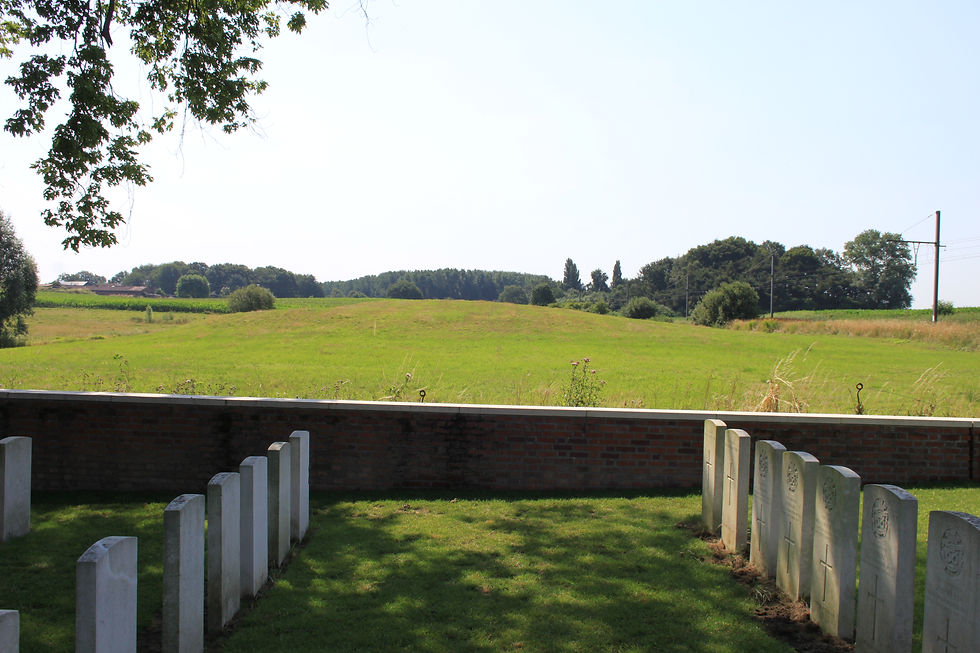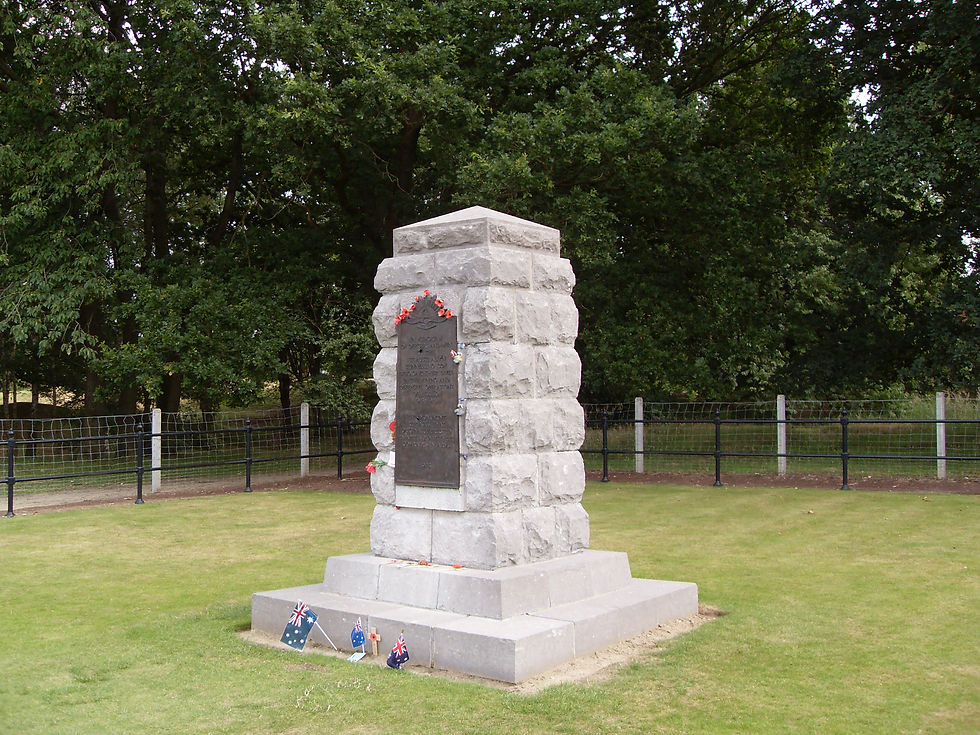Hill 60 & Caterpillar Mines
- Admin
- Apr 4, 2023
- 7 min read
Updated: Oct 11
These were the northern most mines and they were 200 yards apart. Both 171 and 172 Tunnelling Companies had been mining at Hill 60 since their formation. The mining here had been continuous and at an average depth of 4.5 metres (15 feet) and each side had fired two or three camouflets per day, mostly small charges. A virtual stalemate had been reached when General Allenby, commanding V Corps, ordered a deep mining offensive against Hill 60 and the Caterpillar.


In July 1915, 175 TC took over Hill 60 from 171 TC which went south to Ploegsteert. It was 175 TC that started the work and in the spring of 1916, the 3rd Canadian Tunnelling Company relieved 175 TC and took over the famous Berlin Tunnel. The tunnel, which was in the Paniselien or ‘bastard’ clay at 27 metres (90 feet), had, after three months, been driven beneath the hill and the German mining system by the Canadians before they encountered bad ground.

The gallery was close enough to the German lines that they began to create a chamber for the charge. As they enlarged the chamber a cave in occurred with sand, yellow clay and water rushing into the gallery. They sealed the leak and created a series of smaller chambers and laid a mine with 53,500lbs of ammonal and additional 7,800lbs of guncotton priming slabs which they packed into the spaces completing their work on 1 August 1916.

The Canadians now began to dig an intermediate system at 15 metres (50 feet) which was to form a protective screen above their deep galleries and then began the drive towards the Caterpillar, which was the spoil heap from the railway line opposite Hill 60. However, they ran into bad ground once again. Plugging the gallery, they moved to the right and then went down by 4 metres (15 feet) into the clay and then drove the gallery under the German second line and by 20 September they had completed a chamber for the charge of 70,000lbs of ammonal. They were to be delayed once again when gas and water from an earlier captured German gallery flooded the whole of the Berlin Tunnel cutting off the charge. They set about clearing the damage and cleaning out the tunnel and when they eventually reached the charge, they discovered that it was undamaged as the whole 70,000lbs of ammonal was in watertight tins. They now connected three independent sets of firing leads which allowed for nine circuits and sixty detonators to be connected to the charge.

Berlin Shaft
In the first week of November 1916 the Canadians were relieved by the 1st Australian Tunnelling Company. Both mines had intended to be used immediately, but with the change in plans they would not now be fired for seven months. Water was running through the galleries of Hill 60 and the Caterpillar mine was no exception with sixty men kept busy constantly pumping out the water with hand pumps.

It was decided to sink a vertical steel-lined shaft to replace the long incline. Started by the Canadians and taken on by the Australians the Berlin Shaft as it was known, was 2 metres in diameter (6 feet), and was sunk to a depth of 28 metres (94 feet) and the gallery was then driven to the foot of the incline. From here the water was drained to a large sump and was then pumped, using an electric pump, to the top of the shaft. The new shaft improved the ventilation and there was a saving on labour continuously pumping.

Counter mining
The Germans were constantly probing for the British galleries and developing their own mining galleries. The British had fifty listening posts on four levels at 4.5 metres (15 feet), 13 metres (45 feet) known as the intermediate section, and 27 metres (90 feet), with four of these listening posts as close as one metre (6 feet) from one of the main German galleries. One of the tunnelling officers Captain Oliver Ward M.C. recalled: ‘I have listened as immovable as a piece of statuary and as cold, from fear.’ Sounds of German mining were detected above the gallery to the Hill 60 mine. Woodward worked quietly and quickly and blew a camouflet and it was reported that two columns of smoke were seen coming from the enemy lines near to the railway cutting. However, when they checked the leads to the mine, they found that the explosion had damaged them and had to effect repairs. On the 4 and 5 April 1917 the Germans blew two mines of their own causing considerable damage and breaking the leads to the Hill 60 mine. Several of the Australian tunnellers were cut off in a shallow working and it took two days to rescue them. On the 9 April a German raiding party broke into the British lines and they were fought off by the infantry assisted by the tunnellers however, not before they had thrown portable charges into several mine shafts and inflicting casualties. The Germans were not done. On the 10 April they blew another camouflet causing further damage to the two galleries. In early May, tapping was heard near the Hill 60 charge however, it turned out to be a German windlass from a shaft they were creating but it was too far away to be of any danger. An Australian officer described the German activity as ‘It was getting on all our nerves.’
Deadly Accident
On the 25 April 1917, two officers of the 1st Australian Tunnelling Company were killed in an accident at Hill 60. Alexander Barrie, in his book 'War Underground, the Tunnellers of the Great War' recounted what happened: 'The two officers Captain Wilfred Avery and Lieutenant Arthur Tandy, were preparing a guncotton priming charge that was to be used to fire an ammonal camouflet. They passed a light current through the detonators after inserting them in the explosive (this should have been done before) and the charge, 50lbs. of it promptly fired. Avery and Tandy were blown to pieces and the entire dug-out they were in was wrecked; the blast flashed on through the corridor and into the Proto storeroom (where the gas equipment was stored) to take more casualties there.' Total casualties were three officers and seven men dead, four officers and twelve men gassed, many seriously. Barrie recounted the clearing up by Captain William McBride, who he described as a large and cheery extrovert mining engineer from Adelaide: 'He found sand almost filling the dug-out and sieved as much of it as possible, extracting the remains of the two distinguished officers which he wrapped in blankets and sent down for burial with the other bodies.' McBride was awarded the M.C. for completing this terrible task. Both Avery and Tandy are buried in Poperinge New Military Cemetery graves 1.EI.I and 1.EI.2.
Final Checks
On May 15, 1917, Major James henry, commanding officer 1st Australian Tunnelling Company, informed Woodward that he was to be in charge of the firing party. He would be assisted by two other officers Lieutenant Royale and Lieutenant James Bowry, along with an NCO and forty other ranks. On 3 June, the tamping, which had been partially removed from the Hill 60 mine to allow the firing leads to be repaired, was replaced. On the 5 June Woodward was informed by Brigadier-General T.S. Lambert, commanding 69th Infantry Brigade, of the date and time of zero hour and that he, Lambert, would be in the firing dugout with him in order to give the signal. Throughout the 6 June Woodward suffered from nerves however, his attention was focused on the final work still to be done. The electric wires had still to be run back from the shaft to the firing dugout located 400 yards from the mines. There were three separate circuits passing through the two charges and each circuit had its own throw-over switches, if all went well only Woodward’s would be needed with Royale and Bowry and the exploder boxes as a backup. By 1.30am on 7 June the wires were in the firing dugout and only required to be connected to the switches by Woodward.
Armageddon
In his diary published under the title ‘The War Diary of the Master of Belhaven’, R.G. Hamilton commanding artillery battery witnessed the events at Hill 60 and the Caterpillar: ‘At exactly 3.10am Armageddon began. The timing of all the batteries in the area was so wonderful, and so a second every gun roared in one awful salvo. At the same moment the two greatest mines in history were blown up – Hill 60 and one immediately to the south of it. I cleared everyone out of the dugouts and was watching for it. Never could I have imagined such a sight. First, there was a double shock that shook the earth here 15,000 yards away like a gigantic earthquake. I was nearly flung off my feet. Then an immense wall of fire that seemed to go half-way up to heaven. The whole country was lit with a red light like in a photographic dark-room. At the same moment all the guns spoke and the battle began on this part of the line. The noise surpasses event the Somme; it is terrific, magnificent, overwhelming. It makes one almost drunk with exhilaration, and one simply does not care that we are under all concentrated fire of all the Hun batteries.’








Comments